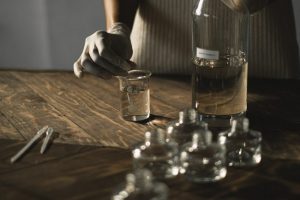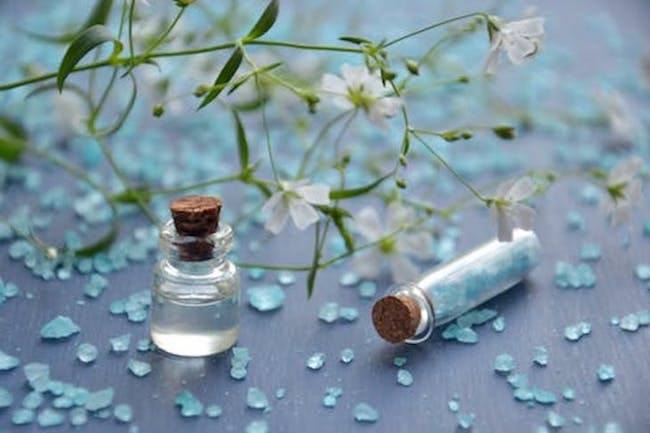Research, Green - Natural - Safe, Choose your lifestyle
Perfume - The unrecognised danger in the bathroom

May
In mid-2012, the beauty scene was suddenly in a frenzy: Chanel's iconic perfume "Chanel No. 5" was placed on a blacklist by the EU and potentially banned. The reason: according to analyses, the perfume contains over 100 hazardous ingredients. We get to the bottom of this:
The art of fragrances and perfumes is an ancient science and part of beauty rituals in all parts of the world. Floral waters and essential oils were used to enhance well-being, to heal and, of course, to seduce. In France, perfumes were used long ago not only to seduce, but also to mask odours (at a time when washing was more dangerous), and even to kill: Fragrant but highly toxic substances were dripped into clothing and gloves, and the slow absorption slowly killed the wearer. The French therefore already knew that toxins could be absorbed into the body through the skin and that even fragrant substances could be poisonous.
mkpkp

It was no coincidence that the EU targeted the world's most famous perfume, "Chanel No. 5". Even if it was unlikely from the outset that this ban would actually be imposed (with media impact), the issue was sure to attract the attention of the media. All the more so the media landscape whose readers usually dismiss warnings of this kind and attribute them to vegan Birkenstock wearers and organic aunties like me. Because what the analyses of the perfume have revealed, the large number of synthetic ingredients, comes as no surprise to industry experts.
From a historical point of view, the selection of Chanel No. 5 was at least as interesting, because this perfume was the first entirely synthetic perfume that came onto the market. It was not developed synthetically for cost reasons, but because Coco Chanel's perfumer was convinced that the synthetic aldehydes would make the scent of the natural essences even more intense.
What makes perfume dangerous?
Perfumes contain a long list of known hazardous and toxic ingredients.
One of these is aldehyde. Aldehyde comes from the same chemical family as the highly carcinogenic formaldehyde, which is used in nail varnishes.
Another highly problematic ingredient is musk (natural or synthetic). Musk is particularly dangerous as this synthetic substance has xenoestrogenic effects that have been linked to infertility, breast cancer, cervical cancer and testicular cancer. This fact has prompted the EU to ban some (!) nitro musk compounds.

Other ingredients in perfumes and fragrances that can have potentially negative effects on health include neurotoxins (which impair the function of nerve tissue), a whole range of allergens, skin-irritating substances and ingredients that can even cause asthma. Often the term "perfume" also conceals the fact that the product in question contains phthalates, a group of highly dangerous hormone disruptors. Analyses of conventional perfumes show that they contain hundreds (!) of neurotoxins, carcinogens and synthetic compounds that interfere with hormone balance and can cause birth defects, among other things.
How do fragrances get into our bodies?
There are many concerns with perfumes and fragrances as they can be inhaled, ingested and absorbed through the skin. We inhale numerous fragrances every day, from perfumes to dishwashing liquids to air fresheners. We also spray perfume directly onto our skin or clothing and inhale it immediately thanks to the latest atomisers.
However, this is not the most problematic aspect, as it is not only the wearer of perfume who is exposed to the hazardous substances, but also babies and children who cuddle with you, as well as everyone in our immediate environment. Breastfeeding mothers expose their babies to a particularly high concentration of synthetic fragrances at a time when the endocrine system (i.e. the hormonal system) is still too weak to deal with them. The toxins then accumulate in the body and unknown effects may only become apparent decades later.
The EU recently published a study showing that young girls exposed to air fresheners (e.g. in the bathroom) started menstruating months earlier than the control group. So this study proves the power of fragrances just by inhaling them once or twice a day for less than 5 minutes!
Also to be noted is the Environmental impact. When fragrances are washed off, whether from the body, laundry or crockery, they get into the water, where they often cannot be filtered and thus get into the groundwater, or are reused as drinking water, for cooking or as bath water.
In addition to health concerns and environmental pollution, the production of synthetic fragrances is not necessarily sustainable. A high consumption of valuable resources goes hand in hand with the production of fragrances.
What alternatives are there to conventional perfumes?
Fortunately, there is a whole range of alternatives for fragrance fans! Essential oils make excellent air fresheners and you can create your own favourite fragrance. Floral waters are suitable as perfumes and for freshening up fabrics. Of course, there are also modern and 100% natural and non-toxic perfumes, such as those from Farfalla, Lotuswei, Lina Hanson and other specialised brands. Of course, these smell different to the latest celebrity perfume, but perhaps that's just as well.
We have put together a selection of safe perfumes here:
Recommendations for customers from Germany & Austria
Recommendations for customers from Switzerland
